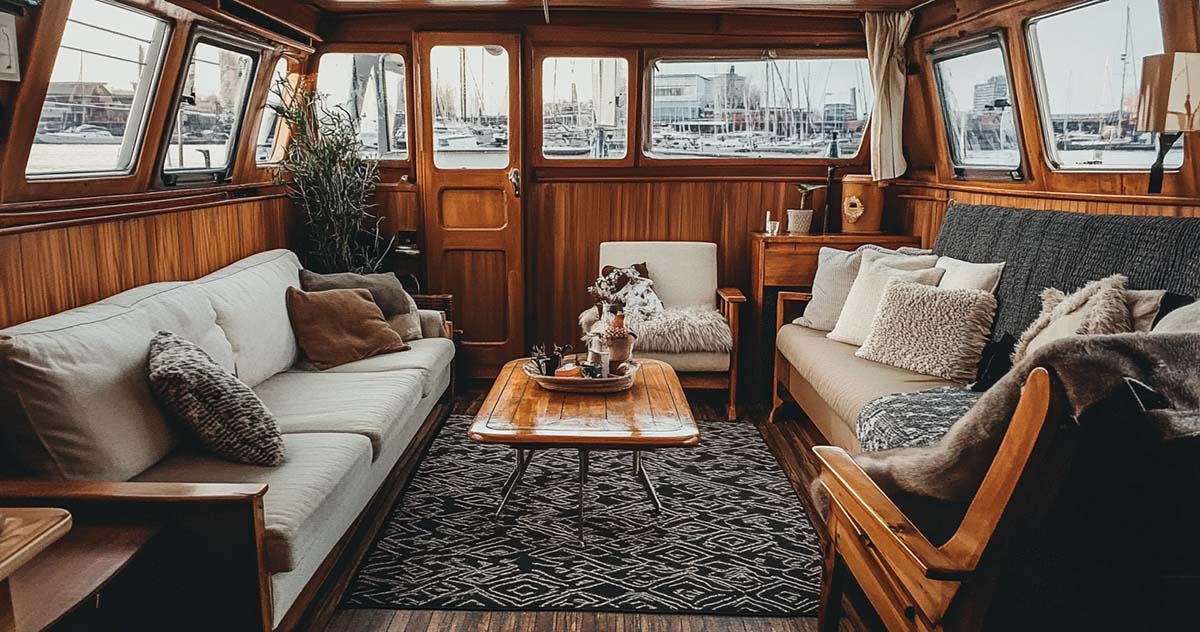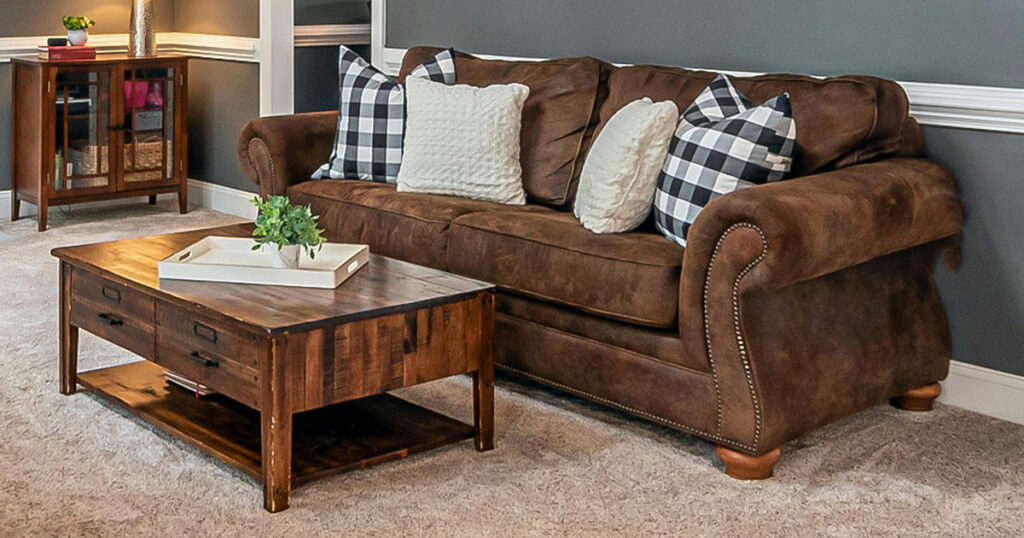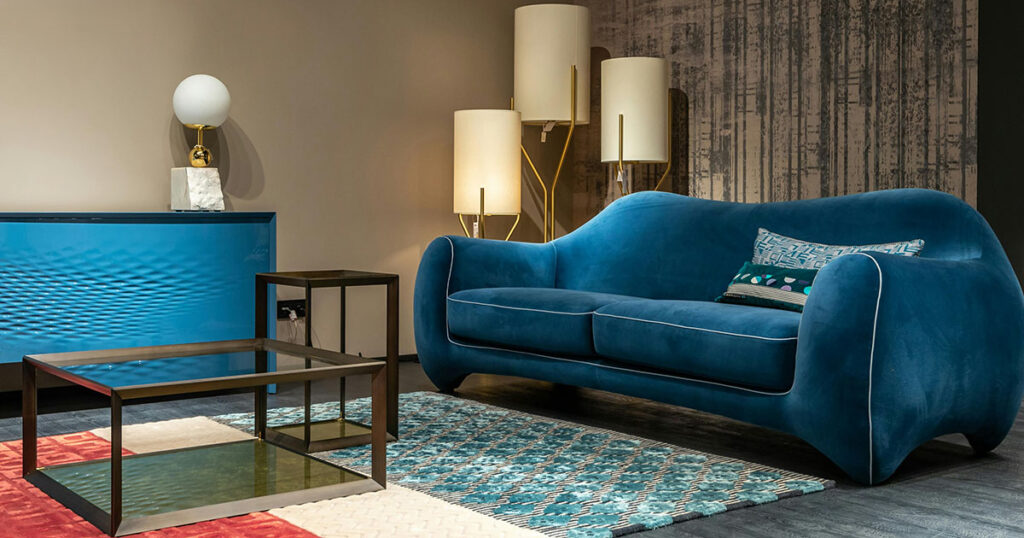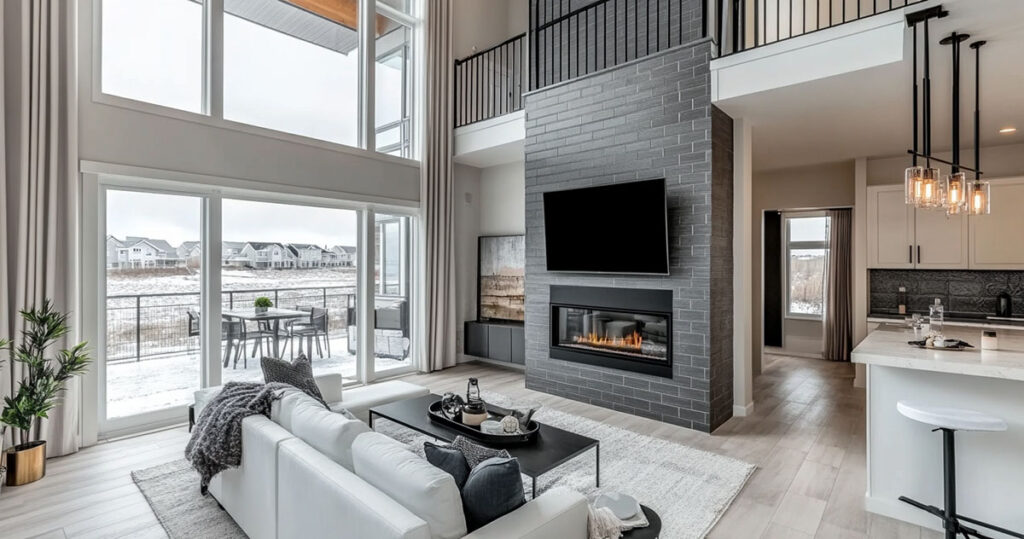Whether you’re refitting your existing yacht or selecting finishes for a new build, understanding the art of choosing rugs specifically designed for marine environments can transform your floating sanctuary into a true home on water.
Let’s explore how to select rugs that balance breathtaking design with practical durability for your yacht’s interior and exterior spaces.
Why Yacht Rugs Matter
The perfect rug does more than just decorate your yacht – it transforms your floating haven into a true luxury experience. On a yacht, rugs fulfill essential roles beyond mere aesthetics.
Quality rugs provide crucial comfort underfoot, especially welcome when moving from the sun-warmed deck to air-conditioned interiors. They add warmth to spaces that might otherwise feel stark with hard surfaces dominating the design. Well-chosen rugs reduce noise by absorbing sounds and vibrations, creating a more peaceful environment away from engine noise and water sounds.
From a design perspective, rugs establish visual zones within open layouts, helping to define separate areas for dining, conversation, and relaxation. The right rug brings together a space’s design elements, adding texture, color, and personality to each area.
But yacht rugs face unique challenges – salt, humidity, sun, and constant movement demand specialized solutions. Let’s explore how to select rugs that enhance your yacht experience while standing up to marine conditions.
Different Spaces, Different Needs
Interior Yacht Rugs
Your yacht’s interior spaces allow for more luxurious materials and thicker, decorative rugs. However, they still must handle marine environments with grace.
Interior rugs should harmonize with your yacht’s overall design theme. In these protected spaces, you have freedom to select premium materials like wool or silk blends that offer exceptional softness underfoot. New Zealand wool remains particularly popular for yacht interiors, providing natural resilience while maintaining luxurious comfort.
For climate considerations, remember that even climate-controlled interiors experience humidity fluctuations. Marine-treated wool carpets work beautifully in cabins and salons, offering natural insulation while helping regulate onboard humidity by absorbing excess moisture without feeling damp.
Custom sizing becomes essential in yacht interiors. Unlike standard rectangular rooms, yachts feature curved walls, built-in furniture, and non-standard shapes. Consider having rugs custom-made to your yacht’s floor plan for a tailored, built-in appearance. Marine carpet suppliers can work from templates to create pieces that follow the elegant curves of your interior spaces.
Don’t overlook practical concerns like door clearances and secure attachments. Cabin doors often swing closer to the floor than residential doors, so rug thickness and edge finishing should allow for smooth movement. Quality underlays or discreet attachment systems keep rugs firmly in place when underway.
Exterior Deck Rugs
Exterior rugs face the full brunt of marine conditions and require true marine-grade performance. These rugs encounter sun, salt, and water daily, making durability the primary concern.
For outdoor yacht spaces, synthetic fibers reign supreme. Look for rugs made from polypropylene, acrylic, or polyester blends specifically labeled for outdoor or marine use. These materials resist water absorption, preventing mold and mildew while withstanding UV damage. Marine carpets typically use polypropylene because it handles sea conditions brilliantly, offering exceptional resistance to moisture and sun exposure.
Construction matters significantly for exterior rugs. These pieces typically feature low pile or flat-woven construction that dries quickly and doesn’t trap water. Marine-grade rugs incorporate special backing and weaves designed for rapid drainage and stability, ensuring water evaporates quickly rather than creating a soggy hazard. Reinforced edges prevent fraying in wind and heavy foot traffic.
UV resistance becomes critical for exterior rugs. Ensure any outdoor pieces carry UV-stabilized protection so colors remain vibrant despite intense sun exposure. Consider that dark-colored rugs absorb heat, while very light colors show stains. Many yacht owners choose medium-tone patterns that balance aesthetics with practicality.
Outdoor rugs should offer simple cleaning solutions. Ideally, choose pieces you can hose down or scrub with mild soap directly on deck. Polypropylene outdoor rugs excel here with fibers that naturally repel liquids and stains.
Yarns That Matter
The Appeal of Wool
Wool represents the classic luxury choice for yacht interiors, offering plush comfort and excellent durability. Its natural fibers provide inherent resilience – springing back from furniture indentations and maintaining their appearance beautifully over time.
Quality wool rugs offer remarkable longevity, often surviving decades with proper care. The material brings natural benefits particularly suited to yachts: it’s flame-retardant (a safety bonus), insulating (keeping cabins comfortable), and naturally somewhat water-resistant thanks to lanolin content.
Wool creates a wonderful tactile experience in all climates, staying cozy in cool weather while feeling less sticky in humid conditions due to its breathable nature. For environmentally conscious yacht owners, wool offers a renewable, eco-friendly option compared to petroleum-based alternatives.
Aesthetically, nothing matches wool’s luxury appeal. From hand-knotted designs to sculptured modern pieces, wool takes dye beautifully and achieves rich visual depth impossible with synthetics.
However, wool does present challenges in marine environments. It absorbs significant moisture (up to 30% of its weight), leading to longer drying times and potential mildew issues if thoroughly soaked. Without treatment, wool becomes vulnerable to mold in warm, damp conditions, though high-end “marine-grade wool” carpets include treatments enhancing mold resistance.
Wool requires dedicated maintenance: regular vacuuming and occasional professional cleaning keep it looking its best. Salt exposure can damage fibers over time if not properly cleaned. Additionally, wool commands a higher price point than most synthetics, making it a significant investment for large yacht spaces.
The Case for Synthetics
Synthetic fiber rugs, particularly polypropylene (olefin), have gained immense popularity for marine applications due to their weather-resistant properties. These materials offer exceptional moisture resistance – the fibers don’t absorb water, preventing rot and mold issues.
Most synthetic marine rugs feature UV stabilization, preserving colors despite strong sunlight exposure. Cleaning becomes remarkably simple: polypropylene and similar synthetics repel most stains naturally, allowing quick cleanup of spills. These materials tolerate more aggressive cleaners – many outdoor rugs can be hosed down or gently scrubbed with diluted solutions without damage.
Modern marine-grade polypropylene carpets deliver impressive durability against wear, pilling, and mildew while maintaining reasonable comfort underfoot. Their cost-effectiveness compared to wool makes them practical for larger yacht spaces or areas requiring frequent replacement.
Today’s synthetic options come in diverse colors and patterns, including styles mimicking natural materials like sisal or wool, eliminating design compromises for practical choices.
The drawbacks of synthetics primarily involve texture, longevity, and environmental impact. While improving steadily, synthetic fibers may not deliver the plush, premium feel of high-grade wool. In high-traffic areas, some synthetics (especially lower-end options) can flatten permanently, lacking wool’s springy resilience. Their lower melting point creates vulnerability to extreme heat sources like dropped cigars or hot pans.
While quality synthetics last years, wool typically ages more gracefully in protected environments. Additionally, as petroleum-based products, synthetics raise environmental concerns for eco-conscious yacht owners, including questions about disposal and potential off-gassing when new.
Regional Influences and Styles
North American Yacht Style
North American yacht owners typically embrace comfort blended with classic nautical elements. Coastal-inspired designs predominate, featuring navy blues, crisp whites, and earth-tone neutrals reflecting seaside landscapes. Traditional maritime motifs like stripes, compass roses, and subtle rope patterns add characteristic flair without overwhelming spaces.
American yacht interiors strike a balance between casual and upscale aesthetics. Plush rugs and wall-to-wall carpeting create homey staterooms, while practical considerations influence material choices. Durable synthetics or wool blends that clean easily remain popular, especially for family cruising or charter vessels.
Regional variations emerge across American waters: West Coast designs often incorporate modern elements or tropical influences, while East Coast styles maintain traditional elegance with tailored sisal-look carpets or subdued oriental patterns. The overall North American approach balances tradition with comfort – creating inviting, stylish spaces without excessive formality.
European Design Sensibilities
European yacht design often leads industry trends, with many premier yacht designers originating from Italy, the Netherlands, and the UK. While styles vary widely, European interiors typically display exceptional design cohesion and creative daring.
Modern European yachts might feature minimalist interiors with clean lines and neutral palettes. In these spaces, rugs provide subtle enhancement through tone-on-tone textures or geometric patterns in sophisticated neutrals, serving as refined backdrops for statement furniture or art pieces.
Alternatively, classic European elegance appears in richly patterned carpets echoing grand estate styling. Another European trend embraces bespoke art rugs – commissioned pieces functioning almost as art installations with abstract patterns or innovative materials creating focal points within interior spaces.
Recent European yacht design has moved away from all-beige environments toward more colorful, bold statements. You might find vibrant contemporary rugs providing dramatic contrast within otherwise neutral lounges. Mediterranean influences sometimes introduce warm regional colors like terracotta, olive, or sea blue into carpet designs.
Regarding placement, European yachts often feature more covered flooring with custom carpeting, creating seamless, integrated appearances. Many Northern European-built vessels incorporate wall-to-wall luxury carpet in salons and cabins, sometimes featuring complex inlays or sculptural elements.
Middle Eastern Luxury Aesthetics
Middle Eastern yacht owners frequently bring opulent luxury and rich cultural heritage into their vessel interiors. Hand-knotted oriental rugs or Persian-inspired carpets appear regularly, introducing elaborate floral or geometric patterns in deep jewel tones like burgundy, gold, royal blue, and emerald.
Even aboard contemporary yachts, subtle nods to regional art might include arabesque patterns or calligraphic elements woven into custom pieces. The cultural emphasis on hospitality influences rug choices – interiors feature extremely plush carpeting creating luxuriously comfortable environments for barefoot relaxation and guest entertainment.
With shoes typically removed in Middle Eastern cultures, the tactile experience of carpet underfoot becomes paramount. Very high pile or exceptionally soft carpets dominate private areas like staterooms. Color palettes trend warmer and more expressive than Western designs, with less concern about neutral versatility since these vessels rarely enter charter service.
Recent trends show Middle Eastern yacht design blending modern elements with traditional luxury – sleek contemporary interiors might feature statement rugs with bold patterns or colors connecting to the owner’s heritage. Middle Eastern-influenced yachts typically incorporate more carpet overall, creating cushioned, insulated interior environments that remain cool underfoot even in hot climates.
Practical Maintenance for Lasting Beauty
Proper maintenance protects your investment in yacht rugs and ensures they continue enhancing your vessel’s beauty. Salt, moisture, and heavy use can age rugs prematurely without appropriate care.
Regular vacuuming removes abrasive sand and salt crystals that grind into fibers and cause wear. Vacuum high-traffic areas frequently – daily during busy periods – using a quality vacuum with adjustable height settings. For delicate rugs, choose gentler suction settings or brushless heads.
Address spills immediately as the yacht’s movement can spread liquids quickly. Blot (never rub) with clean, absorbent cloths, then treat with appropriate cleaners: pH-neutral solutions for wool, general soap solutions for synthetics. After spot cleaning, rinse with fresh water using a damp cloth to remove residue, then dry thoroughly with towels or fans.
Moisture control prevents mold and mildew. If rugs become wet, dry them promptly by hanging in well-ventilated areas or using fans/dehumidifiers. For wall-to-wall carpeting, ensure your yacht’s climate control system manages humidity effectively. Consider treating rugs periodically with marine-safe anti-mildew sprays, especially in damp regions.
Protect rugs from UV damage by drawing shades during peak sun exposure when spaces aren’t in use. UV-protective sprays can extend the life of outdoor rugs. Rotate rugs periodically to distribute wear and sun exposure evenly across the surface.
Schedule deep cleaning for removable rugs once or twice yearly, typically during off-season or maintenance periods. Professional cleaning removes deep dirt and salt that regular vacuuming misses. For synthetic rugs, consider occasional machine shampooing with appropriate cleaners, ensuring complete drying afterward.
When storing rugs during off-seasons or rough weather, always clean them thoroughly first – dirt or moisture trapped in stored rugs creates perfect conditions for mold. Roll (never fold) rugs with the pile facing inward, using acid-free paper or clean sheets between layers. Store in cool, dry environments, avoiding plastic wrapping that traps condensation.
Looking for Yacht Rugs?
Ready to elevate your yacht experience with the perfect rugs?
Contact our design team today for a personalized consultation exploring custom options tailored to your vessel’s unique needs and aesthetic vision.




